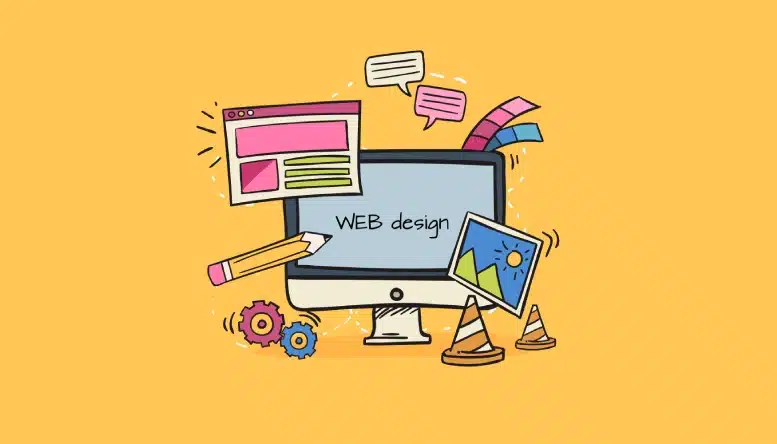Web Design South Africa Predictions: What Will Dominate in the Next 5 Years?
The Impact of Customer Experience on Successful Web Design Strategies
Customer experience (UX) is an essential variable in the performance of internet Design techniques. It encompasses functionality and ease of access, affecting how individuals interact with a web site. A well-crafted UX can result in enhanced engagement and retention. However, numerous developers neglect crucial elements that add to a positive experience. Comprehending these components is very important for success. What specific strategies can improve UX and eventually drive far better outcomes?
Recognizing User Experience: Definition and Importance
Individual experience (UX) works as a critical element in the domain of website design, fundamentally forming just how users engage with digital platforms. It includes the total experience a user has while maneuvering an internet site, including aspects such as contentment, accessibility, and use. A properly designed UX not just boosts user involvement but also influences customer retention and conversion rates. Understanding UX is vital for developers, as it helps determine individual requirements and preferences, permitting the development of instinctive user interfaces. Concentrating on UX promotes a positive psychological reaction from customers, which is important for building brand name commitment. Eventually, a strong focus on user experience can bring about a successful electronic presence, making certain that sites successfully meet individuals' objectives and assumptions.
Trick Components of Efficient Web Design
Effective web Design pivots on several crucial elements that boost individual experience. Instinctive navigating, a distinct aesthetic pecking order, and receptive layout versatility are important for guiding users and guaranteeing ease of access across tools. Comprehending these components can considerably affect the total effectiveness of a web site.
User-friendly Navigating Design
Exactly how can user-friendly navigating Design change a visitor's experience on a site? Instinctive navigating simplifies the individual's journey, allowing site visitors to discover information promptly and efficiently. This type of Design employs clear labels, sensible structure, and familiar designs to decrease confusion. By prioritizing crucial web content and arranging it hierarchically, customers can conveniently find desired pages without unneeded clicks. Furthermore, responsive navigation elements, such as dropdown menus and breadcrumb routes, boost usability across tools. Reliable intuitive navigation not just improves user fulfillment but additionally decreases bounce prices, encouraging longer site engagement. Inevitably, a seamless navigating experience promotes a feeling of trust and self-confidence, making site visitors more probable to return and discover additionally, therefore enhancing the overall success of the web site.
Visual Hierarchy Importance

A well-structured visual hierarchy plays an essential duty in leading individuals via a web site's content, matching the intuitive navigation Design that boosts general customer experience. By prioritizing elements such as dimension, placement, contrast, and shade, designers can properly accentuate crucial information and phones call to activity. This organization enables users to quickly identify crucial areas, assisting in easier understanding and navigation. In addition, a constant aesthetic pecking order assists develop a cohesive brand name identity, reinforcing trust fund and involvement. When customers can easily process info, they are most likely to connect favorably with the site, ultimately resulting in higher conversion rates - Web Design South Africa. Consequently, executing a clear visual hierarchy is an essential aspect of effective website design approaches, greatly influencing individual fulfillment and retention
Responsive Format Flexibility
What makes an internet site genuinely versatile across different gadgets? Receptive layout versatility is vital for guaranteeing perfect customer experience. This Design method utilizes liquid grids, versatile pictures, and CSS media queries to change the format based upon the gadget's screen dimension and resolution. Effective responsive Design not only boosts aesthetic appeal however also improves capability by permitting individuals to navigate effortlessly, despite the system used. Key aspects consist of prioritizing web content pecking order, guaranteeing touch-friendly user interfaces, and preserving quick packing times. By focusing on these aspects, designers can develop sites that deal with varied user needs, inevitably bring about higher customer satisfaction and involvement. In today's electronic landscape, adaptability is no much longer optional; it is necessary for effective website design.
The Role of Navigation in Customer Experience
Effective navigating is important for boosting individual experience on sites. It works as a roadmap, guiding customers easily through numerous areas and content. A well-structured navigating system lessens complication and stress, enabling site visitors to find info quickly. Secret aspects of effective navigation include clearness, simplicity, and consistency. Clear labels help individuals recognize where web links will certainly take them, while consistent positioning strengthens experience throughout pages. In addition, a streamlined food selection can lower cognitive overload, making it much easier for customers to choose. Using dropdowns and breadcrumbs better boosts usability by providing context and added paths. Ultimately, strong navigation cultivates customer satisfaction, encourages longer check outs, and enhances the possibility of conversions, solidifying its important role in successful web Design approaches.
Responsive Design: Satisfying Individual Needs Throughout Gadgets
Receptive Design is increasingly necessary in fitting the diverse variety of gadgets utilized to access the internet today. This technique guarantees that internet sites supply a remarkable watching experience, no matter screen size or alignment. By employing fluid grids, versatile pictures, and media queries, receptive Design permits seamless adaptation throughout smartphones, desktops, and tablet computers. This adaptability not only enhances usability but additionally provides to differing customer preferences and contexts. With even more individuals depending on mobile devices for on the internet communications, the need for responsive Design has actually become crucial in keeping individual fulfillment and interaction. Subsequently, organizations that focus on responsive Design can much better meet individual expectations, which eventually adds to higher retention rates and improved overall performance in the electronic landscape.
Enhancing Individual Involvement Via Visual Design
Aesthetic Design plays a crucial function in boosting individual interaction by leveraging aspects such as shade psychology, typography, and interactive attributes. The strategic use of shades can stimulate emotional actions, while well-chosen typography improves readability and visual charm - Web Design South click here now Africa. Additionally, including interactive aspects fosters user involvement, producing a much more immersive experience
Shade Psychology Consequences
Color psychology plays a necessary duty in shaping individual engagement within website design, as different shades can stimulate distinctive feelings and affect behavior. For circumstances, blue often shares count on and reliability, making it a popular option for company internet sites. On the other hand, red can trigger necessity and exhilaration, regularly seen in call-to-action buttons. Environment-friendly commonly stands for serenity and health and wellness, attracting customers in health and environmental sectors. By tactically selecting colors, developers can develop a visual power structure that overviews user activities and improves the general experience. In addition, regular color design add to brand recognition and commitment. Inevitably, comprehending the mental impacts of shade enables internet developers to craft appealing user interfaces that resonate with individuals, leading to better communications and conversions.
Typography's Role in Involvement
Efficient website design counts not only on shade choices yet additionally on typography, which substantially influences user interaction. The option of font styles, sizes, and spacing can either boost or detract from a user's experience. Clear and clear typography enables individuals to quickly digest material, urging them to invest even more time on an internet site. Furthermore, a regular typographic hierarchy guides the customer's eye, emphasizing crucial information and promoting navigation. Unique typeface options can likewise reflect a brand name's identity, creating a more powerful emotional connection with the audience. Eventually, efficient typography not just enhances readability yet also fosters an aesthetically appealing setting, improving general involvement and motivating customers to return for future communications.
Interactive Elements Significance
While individuals browse a site, the existence of interactive aspects greatly improves their engagement and total experience. These aspects, such as buttons, sliders, and quizzes, welcome individuals to take part actively rather than passively eating web content. By cultivating communication, designers can develop an extra individualized experience, allowing users to attach and check out with the material in significant means. In addition, interactive features can catch focus and keep individuals on the website much longer, reducing bounce prices. They additionally supply instant responses, reinforcing user actions and encouraging more exploration. Subsequently, incorporating interactive elements right into web Design techniques not only raises aesthetic allure yet also significantly adds to customer fulfillment and retention, eventually leading to greater conversion prices.
Gauging Customer Experience: Tools and Techniques
Measuring Resources user experience is necessary for recognizing how properly a web site meets the requirements of its customers. Different devices and strategies are readily available for this purpose, consisting of user testing, surveys, and analytics. User screening usually involves observing actual customers as they engage with a site, supplying understandings right into usability concerns. Studies can gather straight feedback on individual complete satisfaction and regarded value. Analytics tools track user behavior, highlighting areas where users may struggle or shed rate of interest. In addition, heatmaps visualize customer communications, exposing which components attract interest. By using a combination of these techniques, web developers can get a detailed understanding of customer experience, leading to informed Design choices that improve general internet site efficiency.

Frequently Asked Inquiries
How Does Individual Experience Affect Conversion Rates on Websites?
Individual experience substantially affects conversion rates on sites. A seamless interface, intuitive read the full info here navigation, and interesting content can boost individual fulfillment, leading to enhanced depend on and higher chance of finishing preferred activities, therefore boosting general conversions.
What Prevail Individual Experience Blunders in Internet Design?
Usual individual experience blunders in website design include chaotic layouts, slow packing times, inadequate navigating, insufficient mobile optimization, lack of clear calls-to-action, and neglecting access guidelines, every one of which can substantially prevent customer involvement and fulfillment.
Exactly How Often Should Internet Design Be Updated for Optimum User Experience?
Internet Design should be upgraded frequently, preferably every 1-2 years, to adapt to progressing individual preferences and technical innovations. Frequent examinations boost functionality, making sure that the website stays interesting and pertinent for its target market.

Can User Experience Effect SEO Rankings?
Customer experience greatly affects search engine optimization rankings. Website Design Klerksdorp. Look engines prioritize websites that offer seamless navigation, quick packing times, and engaging content, therefore compensating sites that enhance user contentment with higher exposure in search results page
What Are Some Instances of Exceptional Customer Experience in Website Design?
Examples of superb individual experience in web Design include user-friendly navigation, receptive designs, fast packing times, clear phone calls to action, and engaging visuals. These components add to customer fulfillment and urge extended communication with the site.
Customer experience (UX) serves as an important component in the domain name of web Design, fundamentally forming exactly how customers interact with electronic systems. A well-structured aesthetic hierarchy plays a crucial role in leading users with a site's material, complementing the intuitive navigation Design that boosts total individual experience. With more individuals depending on mobile gadgets for on-line communications, the requirement for receptive Design has come to be essential in preserving customer complete satisfaction and interaction. Gauging user experience is vital for recognizing how successfully a web site satisfies the requirements of its users. Customer testing frequently includes observing real individuals as they interact with a website, supplying understandings into use problems.